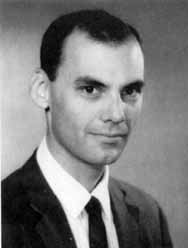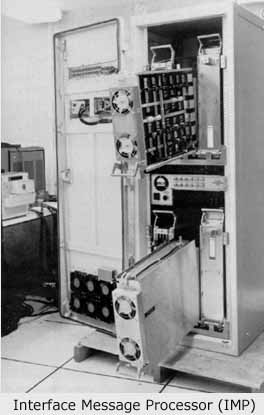Larry
Roberts is sometimes called the "father of the ARPANET." He  earned
this nickname by directing the team of engineers that created the
ARPANET. Roberts was also the principal architect of the ARAPNET.
earned
this nickname by directing the team of engineers that created the
ARPANET. Roberts was also the principal architect of the ARAPNET.
ARPA's
Need for a Network
In
1966, Robert Taylor assumed the directorship of ARPA's Information
Processing Techniques Office (IPTO), J.C.R.
Licklider's old post. He noticed that IPTO research contractors
were constantly requesting more computing resources. Most of them
wanted their own computers—an expensive luxury. Taylor also
noticed that there was a lot of duplication of research. This waste
of resources also cost money. Building on the theoretical legacy of
Licklider, Taylor decided that ARPA should link the existing computers
at ARPA-funded research institutions together. This would allow everybody
on the network to share computing resources and results. He got approval
to go ahead with his plan.
With
the go-ahead to build a network Taylor began looking for someone to
manage the project. His first choice was a young computer scientist
named Larry Roberts. Roberts was a shy man who was well-respected
in his field. He was known for his good management skills and dedication
to his work. Roberts was currently working on graphics at MIT's Lincoln
Laboratory.
Roberts
also had experience with network computing. In 1965, a psychologist
named Tom Marill, who had studied under Licklider and been influenced
by his interest in computers, approached ARPA and proposed a project
to conduct an experiment linking Lincoln Lab's TX-2 computer to the
SDC Q-32 computer in Santa Monica. ARPA officials thought it was a
good idea, but suggested that Marill carry out his experiment under
the sponsorship of the Lincoln Lab, which he did. Officials at the
Lincoln Lab put Roberts in charge of the project. The experiment although
much smaller in scope than the ARAPNET would be was a success. Response
times were slow and connection reliability was often poor, but Marill's
project provided a solid first step.
Roberts,
a respected computer scientist with good management skills who also
had networking experience (which was a rare commodity in those days)
was the ideal candidate to lead ARPA's networking project. The job
would surely be good for Roberts career. Indeed, Taylor had said that
the job would put Roberts in position to become IPTO Director when
Taylor stepped down, but Roberts was happy where he was and did not
want to leave. For nearly a year Taylor tied to persuade him to accept
the position without any luck.
Taylor
would not be dissuaded. He decided to use some strong-arm tactics.
It happened that about half of Lincoln Lab's funding came from ARPA.
Taylor went to ARPA's director, Charles Herzfeld, and asked him to
persuade Lincoln Lab's director to talk Roberts into taking the position.
Herzfeld agreed. Roberts later recalled, "Bob [Taylor] got Herzfeld
to call up the head of Lincoln and say, 'Well, we have 51 percent
of your money. Why don't you send Roberts down here as fast as you
can?' And the head of Lincoln called me in and said, 'It'd probably
be a nice thing for all of us if you'd consider this." (Roberts
in Segaller, 47)
So,
at age 29, Roberts accepted the position of manager and principal
architect of the precursor to the Internet. In 1967, he attended a
meeting for ARPA's Principal Investigators or PIs (scientists heading
ARPA-funded research projects). The main topic was the new networking
project. Roberts laid out his plans. He wanted to connect all ARPA-sponsored
computers directly over dial-up telephone lines. Networking functions
would be handled by "host" computers at each site. This idea was not
well-received. Researchers did not want to relinquish valuable computing
resources to administer this new network and did not see how they
would benefit from sharing resources with other researchers. In 1989,
Roberts recalled:
"Although they knew in
the back of their mind that it was a good idea and were supportive
on a philosophical front, from a practical point of view, they-Minsky
and McCarthy [two prominent PIs], and everybody with their own machine-wanted
[to continue having] their own machine. It was only a couple of
years after they had gotten on [the ARPANET] that they started raving
about how they could now share research, and jointly publish papers,
and do other things that they could never do before." (Roberts
in Abbate, 50)
Many
also foresaw problems trying to facilitate communication between machine
with many different incompatible operating systems and languages.
All in all the reception to Roberts' plans was a cold one.
Toward
the end of the meeting, A man named Wes Clark handed Roberts a note
that read: "You've got the network inside out." (Hafner
& Lyon, 73). After the meeting, Roberts talked with Clark. Clark
 suggested that Roberts employ small computers at each site to handle
networking functions and leave the host computers alone. All of the
small computers could speak the same language which would facilitate
communication between them. Each host computer would only have to
adapt its language once in communicating with it's small computer
counterpart. Each host computer would be connected to the network
via its small computer which would act as a sort of gateway. The small
computers could also remain under more direct ARPA control than were
the large host computers.
suggested that Roberts employ small computers at each site to handle
networking functions and leave the host computers alone. All of the
small computers could speak the same language which would facilitate
communication between them. Each host computer would only have to
adapt its language once in communicating with it's small computer
counterpart. Each host computer would be connected to the network
via its small computer which would act as a sort of gateway. The small
computers could also remain under more direct ARPA control than were
the large host computers.
Roberts adopted Clark's idea. He called the small computers Interface
 Message
Processors (IMPs). Roberts decided that the network should start out
with four sites: UCLA, the Stanford Research Institute (SRI), the
University of Utah, and UC Santa Barbara. This would be the core and
the network could grow from there. (SRI had been chosen as one of
the first sites partly because Doug Engelbart
was there. A few years earlier Bob Taylor had been at NASA and had
funded Engelbart's invention of the first computer mouse.) By the
middle of 1968, Roberts sent out a request for bids to build the IMPs
to 140 companies. In late December, the bidding was over. Bolt Beranek
and Newman, Licklider's old stomping
ground, won.
Message
Processors (IMPs). Roberts decided that the network should start out
with four sites: UCLA, the Stanford Research Institute (SRI), the
University of Utah, and UC Santa Barbara. This would be the core and
the network could grow from there. (SRI had been chosen as one of
the first sites partly because Doug Engelbart
was there. A few years earlier Bob Taylor had been at NASA and had
funded Engelbart's invention of the first computer mouse.) By the
middle of 1968, Roberts sent out a request for bids to build the IMPs
to 140 companies. In late December, the bidding was over. Bolt Beranek
and Newman, Licklider's old stomping
ground, won.
In August 1969, they delivered
the first IMP to UCLA. A month later, the second was delivered to
SRI. The two were connected and the ARAPNET was born.
 Vint
Cerf recalls the delivery of the first IMP to UCLA.
Vint
Cerf recalls the delivery of the first IMP to UCLA.

Home|
Vannevar Bush | J.C.R.
Licklider | Larry Roberts | Paul
Baran |
Bob Metcalfe |
Doug Engelbart | Vint Cerf | Ted
Nelson | Tim Berners-Lee |
Marc Andreesen | Epilogue |
References |